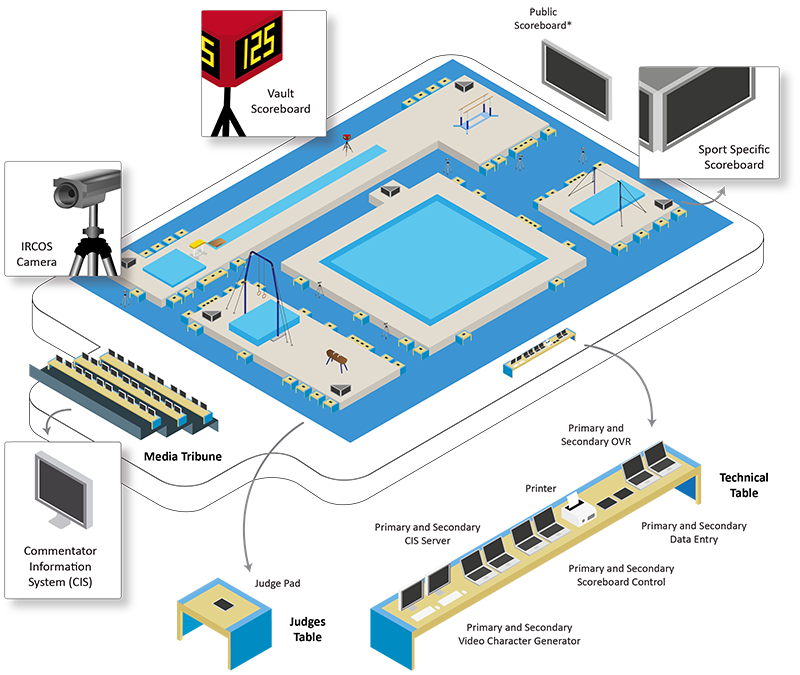With roots in Ancient Greece, Artistic Gymnastics is as ancient as it is spectacular, combining speed, strength, power and flexibility with tumbling and acrobatic skills, all performed with an emphasis on style. The ever-evolving sport continues to adapt for the new millennia as it stays true to the Olympic motto of Citius, Altius, Fortius ("Faster, Higher, Stronger"). Men’s gymnasts display superhuman strength as they challenge gravity and push the limits of physics in six separate events: Floor Exercise, Pommel Horse, Still Rings, Vault, Parallel Bars and Horizontal Bar. Artistic Gymnastics is one of the most popular, celebrated and thoroughly modern sports for women, having undergone more transformation than perhaps any other Olympic sport. With a thrilling combination of daring and grace, gymnasts perform challenging elements on four apparatus - Vault, Uneven Bars, Balance Beam and Floor Exercise - with emphasis on agility, artistry, flexibility, power and style. Though it has much in common with Men's Gymnastics, Women's Artistic Gymnastics is distinctly unique and is a showcase for excellence in women's sport. On all events, gymnasts are judged on difficulty of the exercise, execution, along with dynamics, including height and distance from apparatus, and must show strength, flexibility, balance and rhythmic.
The roots of rhythmic gymnastics can be traced back centuries but the sport as it is practiced today first started to gain popularity in the 20th century. In this gymnastic discipline, athletes perform to music and work with different apparatus. They are judged on difficulty, artistry and execution. Swiss Timing has worked with the International Gymnastics Federation (FIG) since 1987 and provides scoring and judging systems that are regularly updated following the ever-evolving rules of rhythmic gymnastics.
Aerobic exercise has been a popular way for the general public to stay fit since the 1980s but it has also become a top-level competitive sport. The first Official Aerobic Gymnastic World Championships were held in 1995 and the discipline’s popularity has grown ever since. Aerobic gymnasts demonstrate dynamic moves, strength, flexibility, coordination, and musicality in routines. Swiss Timing delivers scoring systems that allow judges’ points to be correctly and quickly recorded in routines that include elements in the categories of dynamic strength, static strength, jumps, and flexibility/balance.
Many of us have experienced the exhilaration of jumping on a trampoline and propelling our bodies high into the air, maybe even risking a flip or improvised trick. The fact is that trampoline is a relatively new invention – the first one appeared in 1936. Its popularity soared (appropriately) and in 1964 the first world trampoline championships took place. The International Trampoline Federation merged with the International Gymnastics Federation in 1998, and two years later trampoline became part of the Olympic Games as a FIG discipline. Trampoline gymnasts in competition are judged on four main factors: execution, difficulty, horizontal displacement and time of flight. Swiss Timing’s timing and scoring system allows the quick recording of judges’ scores on execution and difficulty, and electronically measures the time of flight and horizontal displacement.
Acrobatic gymnastics has a millennia-old history but the sports acrobatics discipline has only been a part of the International Gymnastics Federation since 1998. Its first World Championships in the FIG era took place in Ghent, Belgium in 1999. Competitors are scored for difficulty, execution,and artistry (including choreography, musicality, expression, and partnership) by panels of specialist judges. Swiss Timing’s dedicated primary and secondary scoring systems ensure that the judges’ results are quickly and accurately recorded and distributed to the scoreboards and the media information system (MIS).
Originating in the street, Parkour can be summed up as the art of getting from one point to another while respecting a key principle: efficiency and fluidity. Parkour was originally developed as a training method, but over the years it has inspired a variety of sporting events and action films, gaining a large following in the process.
In FIG events, the Parkour zone is dotted with a variety of blocks, walls and bars designed to reflect the different obstacles found in urban areas. To overcome them, athletes must use a series of techniques, such as cat leap, arm jump, drop jump and wall run.
There are two categories: Speed and Freestyle. In the speed event, athletes must clear obstacles as quickly as possible to reach the finish line in the shortest possible time. In the freestyle event, athletes use the obstacles to demonstrate their style and creativity, while being judged on their technical performance.




